Vertical Lift Module Market
Vertical Lift Module Market Size and Share Forecast Outlook 2025 to 2035
Vertical lift module market is projected to grow from USD 2.1 billion in 2025 to USD 5.1 billion by 2035, at a CAGR of 9.3%. 3-4 m will dominate with a 42.0% market share, while e-commerce/3pl will lead the end use segment with a 39.0% share.
Vertical Lift Module Market Forecast and Outlook 2025 to 2035
The global vertical lift module (VLM) market is projected to grow from USD 2.1 billion in 2025 to approximately USD 5.1 billion by 2035, recording an absolute increase of USD 3.0 billion over the forecast period. This translates into a total growth of 142.9%, with the market forecast to expand at a compound annual growth rate (CAGR) of 9.3% between 2025 and 2035.
The overall market size is expected to grow by nearly 2.4X during the same period, supported by increasing warehouse automation demand, growing e-commerce fulfillment requirements, and rising space optimization needs driving premium automated storage procurement across various logistics and manufacturing applications.
Quick Stats for Vertical Lift Module Market
- Vertical Lift Module Market Value (2025): USD 2.1 billion
- Vertical Lift Module Market Forecast Value (2035): USD 5.1 billion
- Vertical Lift Module Market CAGR: 9.3%
- Leading Segment by Tray Width (2025): 3 - 4 m (42.0%)
- Leading Segment by End Use (2025): E-commerce/3PL (39.0%)
- Leading Segment by Control (2025): WMS-integrated (61.0%)
- Key Growth Regions: North America, Europe, and Asia Pacific
- Top Companies by Market Share: Kardex, Hänel, Modula
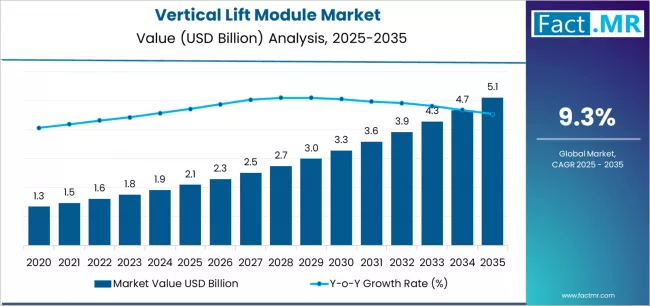
The first half of the decade (2025-2030) is expected to witness substantial market growth, with the VLM market rising from USD 2.1 billion to approximately USD 3.3 billion. This period will be characterized by strong adoption in sectors such as retail, e-commerce, pharmaceuticals, and automotive spare parts distribution, where rapid order fulfillment and efficient inventory management are critical. Companies will increasingly deploy VLM systems to reduce storage footprint, improve picking accuracy, and enhance workforce productivity. Additionally, advancements in software integration, real-time inventory tracking, and connectivity with warehouse management systems (WMS) will further accelerate adoption. The increasing focus on lean warehousing, reducing operational costs, and optimizing space utilization in urban logistics hubs will make VLM systems a preferred solution over conventional shelving systems.
The latter half of the forecast period (2030-2035) is projected to witness further growth from USD 3.3 billion to USD 5.1 billion. This phase will be driven by widespread deployment in high-density fulfillment centers, large-scale manufacturing units, and cold-chain storage applications, where vertical automation offers significant efficiency gains. Integration with robotics, automated guided vehicles (AGVs), and AI-powered inventory management will enhance the functionality of VLMs, enabling predictive analytics and dynamic storage allocation. Sustainability trends and energy-efficient designs will also influence procurement decisions, as companies seek solutions that minimize energy consumption while maximizing storage capacity.
Regionally, North America and Europe are expected to maintain their leadership positions due to the presence of advanced logistics networks, high technology adoption, and well-established automation ecosystems. However, the Asia-Pacific region is projected to register the fastest growth, driven by rapid e-commerce expansion, increasing industrial production, and large-scale warehouse modernization projects in countries such as China, India, Japan, and Southeast Asian nations. Latin America and the Middle East & Africa are anticipated to present moderate but steady growth, fueled by new distribution hubs, expanding industrial zones, and rising awareness of automation benefits.
Despite the positive trajectory, certain challenges may impact the market, including high initial investment costs, maintenance requirements, and the need for skilled personnel to operate and manage automated systems. Providers that offer turnkey solutions, flexible financing options, and post-sale support are likely to gain a competitive advantage. Overall, the vertical lift module market is poised for robust expansion over the next decade, driven by technological innovation, operational efficiency requirements, and growing demand for compact, high-performance automated storage systems across multiple industries.
Vertical Lift Module Market Key Takeaways
| Metric | Value |
|---|---|
| Market Value (2025) | USD 2.1 billion |
| Market Forecast Value (2035) | USD 5.1 billion |
| Forecast CAGR (2025-2035) | 9.3% |
Why is the Vertical Lift Module Market Growing?
| AUTOMATION & SPACE OPTIMIZATION TRENDS | E-COMMERCE & FULFILLMENT REQUIREMENTS | REGULATORY & EFFICIENCY STANDARDS |
|---|---|---|
| Global Warehouse Automation Growth | Advanced Storage Density Requirements | Workplace Safety Standards |
| Continuous expansion of warehouse automation across established and emerging markets driving demand for vertical storage solutions. | Modern e-commerce fulfillment requires high-density storage systems delivering precise inventory access and enhanced operational efficiency. | Regulatory requirements establishing safety benchmarks favoring automated storage systems with advanced safety features. |
| Space Utilization Optimization | Processing Speed Demands | Operational Efficiency Standards |
| Growing emphasis on vertical space utilization and real estate cost optimization creating demand for automated vertical storage applications. | Logistics operators investing in high-speed vertical lift systems offering consistent item retrieval while maintaining accuracy and throughput reliability. | Quality standards requiring superior load-bearing properties and resistance to operational stresses in automated environments. |
| Premium Automation Positioning | Quality and Reliability Standards | Energy Efficiency Requirements |
| Superior storage density and automation characteristics making vertical lift modules essential for premium warehouse and manufacturing applications. | Certified manufacturers with proven track records required for advanced automated storage and high-throughput fulfillment applications. | Diverse energy efficiency requirements and sustainability standards driving need for energy-optimized vertical storage solutions. |
Vertical Lift Module Market Segmentation
| Category | Segments Covered |
|---|---|
| By Tray Width | 3-4 m, <3 m, >4 m |
| By End Use | E-commerce/3PL, Automotive/Aerospace, Healthcare & Others |
| By Control | WMS-integrated, Standalone |
| By Region | North America, Europe, Asia Pacific, Latin America, Middle East & Africa |
Vertical Lift Module Market Analysis by Tray Width
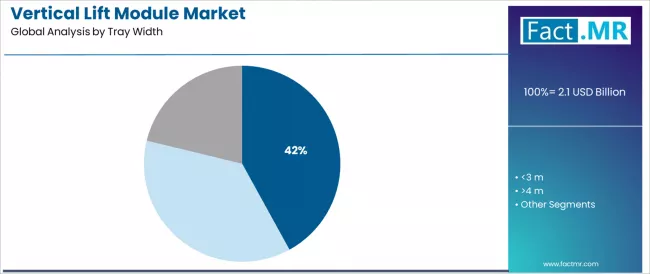
| Segment | 2025 to 2035 Outlook |
|---|---|
| 3-4 m | Leader in 2025 with 42.0% market share; likely to maintain leadership through 2035. Optimal balance of storage capacity and operational flexibility for most warehouse and manufacturing applications. Momentum: steady-to-strong. Watchouts: space constraint limitations, load capacity requirements, installation complexity in existing facilities. |
| <3 m | Strong segment with 38.0% market share due to compact installation advantages and suitability for smaller facilities and specialized applications. Benefits from lower space requirements and simplified installation processes. Momentum: steady growth driven by small to medium facility automation and retrofit applications. |
| >4 m | Represents 20.0% market share, benefiting from maximum storage density advantages in large-scale automated facilities requiring high-volume storage capacity. Strong in distribution centers and mega-fulfillment applications. Momentum: rising in large-scale applications. Watchouts: higher installation complexity, structural requirements, specialized facility design needs. |
Vertical Lift Module Market Analysis by End Use
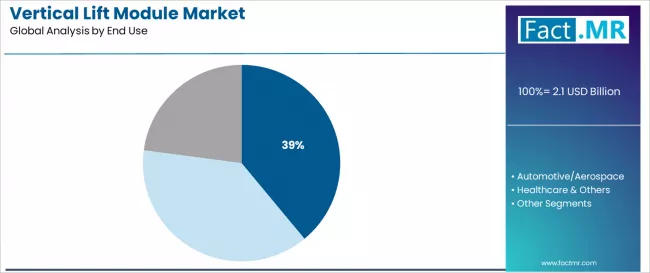
| Segment | 2025 to 2035 Outlook |
|---|---|
| E-commerce/3PL | At 39.0%, largest end-use segment in 2025 with explosive growth driven by online retail expansion and third-party logistics automation. Mature technology adoption, standardized specifications. Momentum: strong growth driven by e-commerce boom and fulfillment center optimization. Watchouts: seasonal demand fluctuations, rapid inventory turnover requirements, peak capacity planning challenges. |
| Automotive/Aerospace | Strong segment with 36.0% share driven by parts storage optimization and manufacturing efficiency requirements in complex supply chain environments. Benefits from precision parts management and quality control integration needs. Momentum: steady growth through manufacturing modernization and supply chain optimization initiatives. Watchouts: industry cyclicality, specialized handling requirements, stringent quality control protocols. |
| Healthcare & Others | Holds 25.0% share encompassing pharmaceutical storage, laboratory applications, and specialized industries requiring controlled environment storage. Growing emphasis on regulatory compliance and inventory accuracy driving specialized storage requirements. Momentum: moderate growth via healthcare automation and regulatory compliance enhancement. Watchouts: strict regulatory requirements, temperature control needs, validation and documentation complexity. |
Vertical Lift Module Market Analysis by Control
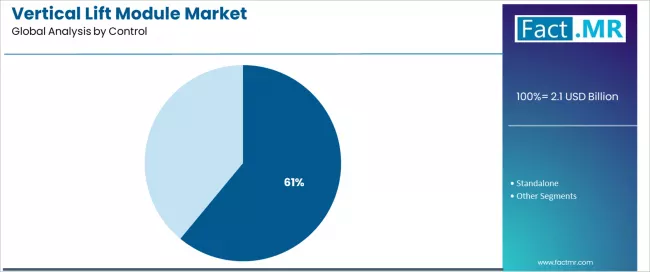
| Segment | 2025 to 2035 Outlook |
|---|---|
| WMS-integrated | Dominant segment with 61.0% market share due to seamless warehouse management system integration and operational efficiency advantages. Benefits from real-time inventory tracking and automated workflow optimization. Momentum: strong growth driven by digital transformation and integrated automation trends. Watchouts: system compatibility complexity, software upgrade requirements, integration costs and implementation timelines. |
| Standalone | Represents 39.0% market share, favored for simple applications and facilities without complex warehouse management system requirements. Strong in smaller operations and specialized storage applications requiring basic automation. Momentum: moderate growth in specialized applications despite integration trends. Watchouts: limited scalability, manual process dependencies, reduced operational optimization compared to integrated systems. |
DRIVERS
| DRIVERS | RESTRAINTS | KEY TRENDS |
|---|---|---|
| Global E-commerce Expansion | High Capital Investment | Advanced Automation Technologies |
| Continuing expansion of e-commerce operations across established and emerging markets driving demand for automated vertical storage solutions. | Significant capital investment requirements for vertical lift module installations affecting adoption rates among small and medium-sized operations. | Integration of AI-powered inventory management, predictive maintenance, and IoT connectivity enabling superior operational efficiency. |
| Warehouse Space Optimization | Installation Complexity | Smart Storage Integration |
| Increasing recognition of vertical space utilization importance in warehouse efficiency and real estate cost management across logistics applications. | Complex installation requirements and facility modifications needed for vertical lift modules affecting implementation timelines and costs. | Enhanced sensor integration, real-time monitoring capabilities, and intelligent space optimization compared to traditional storage solutions. |
| Premium Automation Positioning | Technology Integration Challenges | Sustainable Solutions Development |
| Growing demand for storage systems that support both density optimization and operational efficiency in premium automated warehouse applications. | Integration complexity with existing warehouse management systems and legacy infrastructure affecting deployment efficiency and operational benefits. | Development of energy-efficient drive systems and recyclable component materials providing enhanced environmental compliance and operational cost reduction. |
Analysis of Vertical Lift Module Market by Key Countries
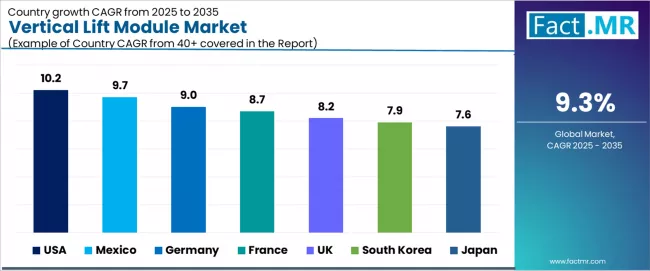
| Country | CAGR (2025-2035) |
|---|---|
| USA | 10.2% |
| Mexico | 9.7% |
| Germany | 9.0% |
| France | 8.7% |
| UK | 8.2% |
| South Korea | 7.9% |
| Japan | 7.6% |
USA Leads Global Market Growth with E-commerce Excellence
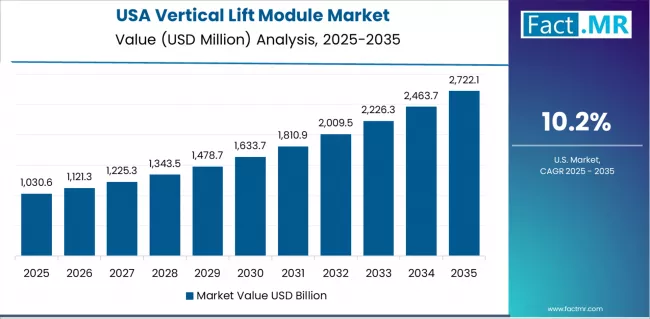
Revenue from the vertical lift modules market in USA is projected to exhibit strong growth with a market value of USD 1.6 billion by 2035, driven by expanding e-commerce infrastructure and comprehensive warehouse automation creating substantial opportunities for vertical storage suppliers across fulfillment center operations, manufacturing facilities, and logistics applications. The country's established e-commerce ecosystem and expanding automated storage capabilities are creating significant demand for both standard and custom-configured vertical lift systems. Major logistics companies and manufacturers including Amazon, FedEx, and automotive facilities are establishing comprehensive vertical storage installations to support high-density operations and meet growing demand for efficient space utilization solutions.
- E-commerce infrastructure expansion programs are supporting widespread adoption of vertical lift modules across fulfillment operations, driving demand for high-density automated storage solutions
- Warehouse automation initiatives and distribution center development are creating substantial opportunities for vertical storage suppliers requiring reliable performance and scalable automation solutions
- Manufacturing modernization and space optimization development are facilitating adoption of advanced vertical storage technologies throughout major industrial regions
Mexico Demonstrates Strong Market Potential with Manufacturing Growth
Revenue from the vertical lift modules market in Mexico is expanding to reach USD 720 million by 2035, supported by extensive manufacturing expansion and comprehensive industrial development creating sustained demand for reliable vertical storage solutions across diverse manufacturing categories and automotive production segments. The country's growing manufacturing base and expanding trade relationships are driving demand for storage solutions that provide consistent inventory management while supporting cost-effective production requirements. Vertical storage manufacturers and system integrators are investing in local facilities to support growing industrial operations and manufacturing automation demand.
- Manufacturing operations expansion and industrial automation capability development are creating opportunities for vertical storage solutions across diverse production segments requiring reliable performance and competitive installation costs
- Automotive industry modernization and production efficiency advancement are driving investments in vertical storage supply chains supporting manufacturing requirements throughout major industrial regions
- Trade facilitation growth and logistics development programs are enhancing demand for space-optimized storage systems throughout Mexican manufacturing areas
Germany Maintains Leadership with Industrial Innovation
Demand for Vertical Lift Modules in Germany is projected to reach USD 620 million by 2035, supported by the country's leadership in industrial automation and advanced manufacturing technologies requiring sophisticated vertical storage systems for automotive production and precision manufacturing applications. German companies are implementing high-quality vertical storage procurement that supports advanced manufacturing techniques, operational efficiency, and comprehensive quality protocols. The market is characterized by focus on operational excellence, system sustainability, and compliance with stringent industrial safety and performance standards.
- Industrial automation industry investments are prioritizing advanced vertical storage technologies that demonstrate superior space utilization and quality while meeting German manufacturing and safety standards
- Manufacturing technology leadership programs and operational excellence initiatives are driving adoption of precision-engineered vertical storage systems that support advanced production requirements and efficiency optimization
- Research and development programs for industrial enhancement are facilitating adoption of specialized vertical storage technologies throughout major manufacturing innovation centers
France Expands Market with Logistics Innovation
Revenue from the vertical lift modules market in France is growing to reach USD 530 million by 2035, driven by logistics innovation development programs and increasing industrial automation creating sustained opportunities for vertical storage suppliers serving both manufacturing operations and distribution center contractors. The country's established manufacturing base and expanding e-commerce logistics are creating demand for storage solutions that support diverse inventory management requirements while maintaining operational efficiency standards. Vertical storage suppliers and system integrators are developing procurement strategies to support operational efficiency and regulatory compliance.
- Logistics innovation development programs and industrial automation are facilitating adoption of vertical storage solutions capable of supporting diverse inventory management requirements and competitive efficiency standards
- Manufacturing automation innovation and production technology development programs are enhancing demand for advanced vertical storage systems that support operational efficiency and reliability
- EU regulatory compliance and specialty system development are creating opportunities for advanced vertical storage technologies across French industrial facilities
UK Demonstrates Market Potential with Distribution Excellence
Revenue from the vertical lift modules market in United Kingdom is expanding to reach USD 450 million by 2035, supported by extensive distribution sector expansion and comprehensive logistics industry development creating sustained demand for reliable vertical storage solutions across diverse e-commerce categories and manufacturing segments. The country's established logistics infrastructure and expanding automated distribution capabilities are driving demand for storage solutions that provide consistent performance while supporting cost-effective operations. Vertical storage processors and logistics suppliers are investing in local capabilities to support growing distribution operations and industrial storage demand.
- Distribution sector operations expansion and logistics automation capability development are creating opportunities for vertical storage solutions across diverse handling segments requiring reliable performance and competitive operational costs
- E-commerce logistics modernization and automation advancement are driving investments in vertical storage supply chains supporting inventory management requirements throughout major distribution regions
- Post-Brexit logistics adaptation and specialty system development programs are enhancing demand for flexible vertical storage systems throughout British distribution areas
South Korea Focuses on Advanced Manufacturing Excellence
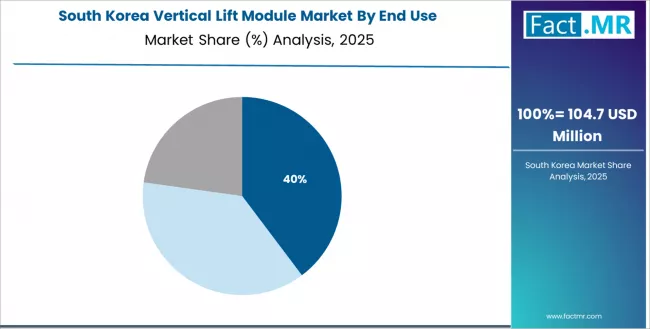
Demand for Vertical Lift Modules in South Korea is projected to reach USD 380 million by 2035, expanding at a CAGR of 7.9%, driven by advanced manufacturing excellence and specialty automation capabilities supporting high-tech production and comprehensive industrial applications. The country's established manufacturing tradition and growing automation market segments are creating demand for high-quality vertical storage solutions that support operational performance and technical standards. Vertical storage suppliers and manufacturing companies are maintaining comprehensive development capabilities to support diverse production requirements.
- Advanced manufacturing and specialty automation programs are supporting demand for precision vertical storage systems that meet contemporary quality and performance standards
- High-tech production development and manufacturing automation programs are creating opportunities for specialized vertical storage solutions that provide comprehensive inventory management support
- Manufacturing export excellence and system quality enhancement programs are facilitating adoption of advanced vertical storage capabilities throughout major production regions
Japan Demonstrates Traditional Manufacturing Integration
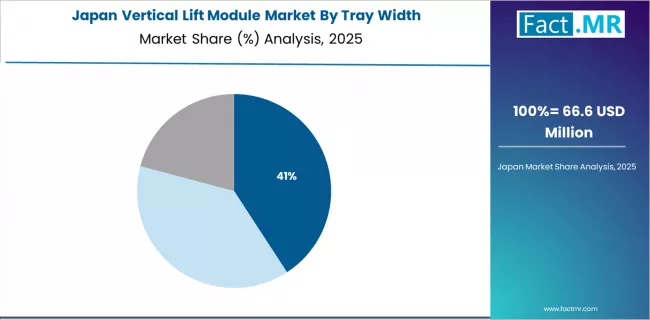
Demand for Vertical Lift Modules in Japan is projected to reach USD 320 million by 2035, expanding at a CAGR of 7.6%, driven by traditional manufacturing integration excellence and comprehensive automation industry capabilities supporting precision production and advanced industrial applications. The country's established manufacturing tradition and growing efficiency market segments are creating demand for high-quality vertical storage solutions that support operational precision and reliability standards. Vertical storage suppliers and industrial manufacturers are maintaining comprehensive development capabilities to support diverse manufacturing requirements.
- Traditional manufacturing integration and automation industry programs are supporting demand for precision-engineered vertical storage systems that meet contemporary quality and operational efficiency standards
- Production efficiency enhancement and manufacturing automation programs are creating opportunities for specialized vertical storage solutions that provide comprehensive inventory management support
- Quality excellence and system enhancement programs are facilitating adoption of advanced vertical storage capabilities throughout major manufacturing regions
Europe Market Split by Country
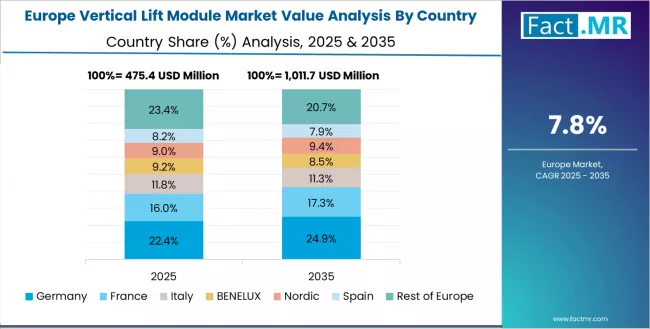
The vertical lift module market in Europe is projected to grow from USD 560 million in 2025 to USD 1.3 billion by 2035, registering a CAGR of 8.7% over the forecast period. Germany is expected to maintain its leadership position with a 29.8% market share in 2025, supported by its advanced manufacturing industry and comprehensive industrial automation capabilities including major facilities for automotive manufacturers and logistics companies.
France follows with a 21.2% share in 2025, projected to reach 21.5% by 2035, driven by comprehensive logistics innovation programs and industrial modernization initiatives. The United Kingdom holds a 18.9% share in 2025, expected to maintain 18.6% by 2035 despite post-Brexit operational adjustments. Italy commands a 15.3% share, while Spain accounts for 9.3% in 2025. The Rest of Europe region is anticipated to gain momentum, expanding its collective share from 5.7% to 6.2% by 2035, attributed to increasing industrial automation in Nordic countries and emerging Eastern European manufacturing facilities implementing automated storage systems.
Premium Quality Standards Define Japanese Market Dynamics
Japanese vertical lift module operations reflect the country's exacting quality standards and sophisticated manufacturing requirements. Major automotive and electronics manufacturers including Toyota, Honda, and Sony maintain rigorous supplier qualification processes that often exceed international standards, requiring extensive documentation, system testing, and facility audits that can take 12-18 months to complete. This creates high barriers for new suppliers but ensures consistent quality that supports premium manufacturing positioning.
The Japanese market demonstrates unique precision requirements, with significant demand for ultra-precise vertical storage systems tailored to lean manufacturing applications including just-in-time inventory management, quality control integration, and flexible manufacturing systems. Companies require specific positioning accuracy and operational reliability that differ from Western applications, driving demand for specialized control and engineering capabilities.
Regulatory oversight through the Ministry of Economy, Trade and Industry emphasizes comprehensive safety standards and operational efficiency requirements that surpass most international benchmarks. The industrial equipment certification system requires detailed performance documentation, creating advantages for suppliers with transparent engineering data and comprehensive quality validation.
Supply chain management focuses on relationship-based partnerships rather than purely transactional procurement. Japanese companies typically maintain long-term supplier relationships spanning decades, with annual contract negotiations emphasizing system reliability and performance consistency over price competition. This stability supports investment in specialized manufacturing equipment tailored to Japanese precision specifications.
Market Dynamics Drive Innovation in South Korea
South Korean vertical lift module operations reflect the country's advanced manufacturing sector and export-oriented business model. Major industrial conglomerates including Samsung, Hyundai, and LG drive sophisticated procurement strategies, establishing direct relationships with global suppliers to secure consistent quality and pricing for their manufacturing and logistics operations targeting both domestic and international markets.
The Korean market demonstrates particular strength in applying vertical lift modules to high-tech manufacturing applications, with companies developing innovative installations that integrate advanced automation with traditional Korean manufacturing excellence and efficiency principles. This innovation approach creates demand for specific system specifications that often exceed standard applications, requiring suppliers to adapt engineering and control technologies.
Regulatory frameworks emphasize manufacturing safety and export competitiveness, with Korean Agency for Technology and Standards requirements often exceeding international benchmarks. This creates barriers for lower-quality suppliers but benefits established manufacturers who can demonstrate advanced system capabilities. The regulatory environment particularly favors suppliers with comprehensive documentation and quality management systems.
Supply chain efficiency remains critical given Korea's integration with global manufacturing markets. Companies increasingly pursue long-term contracts with suppliers in Germany, Japan, and the United States to ensure reliable access to high-quality vertical storage components while managing technology transfer and foreign exchange risks. Advanced logistics investments support system integration during complex manufacturing installations.
Competitive Landscape of Vertical Lift Module Market
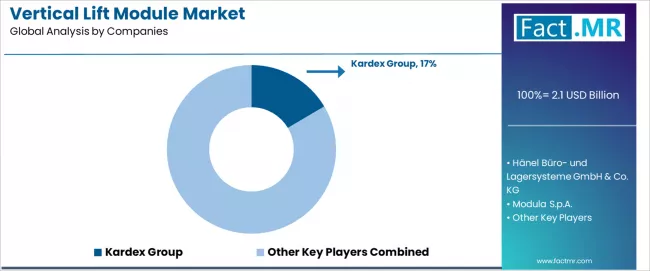
Profit pools are consolidating upstream in scaled system design and manufacturing capabilities and downstream in value-added integrated storage solutions for e-commerce, manufacturing, and logistics applications. Value is migrating from basic vertical storage manufacturing to specification-tight, fully integrated automated storage solutions where warehouse management system compatibility, operational reliability, and consistent performance command premiums.
Several archetypes set the pace: global automation leaders defending share through comprehensive solutions and installation expertise; specialized vertical storage manufacturers that manage engineering complexity and customer customization; software-integrated companies with WMS connectivity IP and data analytics capabilities; and e-commerce solution providers pulling volume in high-throughput fulfillment and distribution applications.
Switching costs—system integration requirements, warehouse layout modifications, operational workflow changes—stabilize market position for incumbents, while technology disruptions (AI integration, predictive analytics, energy efficiency demands) and industry evolution trends reopen opportunities for innovative storage designs. Consolidation and vertical integration continue; digital integration becomes essential as basic storage functionality commoditizes. Market dynamics favor suppliers with comprehensive engineering capabilities, software integration expertise, and established logistics industry relationships.
The competitive environment presents both opportunities and constraints. Premium automation requirements create barriers for basic storage manufacturers but establish standards that favor integrated system solutions over standalone equipment. Software integration and data analytics increasingly influence procurement decisions as operators demand seamless warehouse management connectivity and operational optimization.
| Stakeholder Type | Primary Advantage | Repeatable Plays |
|---|---|---|
| Global automation leaders | Comprehensive solutions, installation expertise, scale | Long-term customer partnerships, integrated project delivery, automation compatibility |
| Specialized manufacturers | Engineering expertise, customization capabilities | Technical differentiation, niche applications, specialized industry focus |
| Software-integrated companies | WMS connectivity, data analytics capabilities | Technology leadership, intelligent storage systems, operational optimization |
| E-commerce solution providers | High-throughput applications, fulfillment expertise | Distribution center optimization, peak capacity handling, rapid deployment capabilities |
Key Players in the Vertical Lift Module Market
- Kardex Group
- Hänel Büro- und Lagersysteme GmbH & Co. KG
- Modula S.p.A.
- SSI Schäfer AG
- Mecalux S.A.
- Daifuku Co., Ltd.
- Automha S.A.
- Jungheinrich AG
- Interroll Holding AG
- Toyota Material Handling, Inc.
Scope of the Report
| Items | Values |
|---|---|
| Quantitative Units | USD 2.1 Billion |
| Product | 3-4 m, <3 m, >4 m |
| End Use | E-commerce/3PL, Automotive/Aerospace, Healthcare & Others |
| Regions Covered | North America, Latin America, Europe, Asia Pacific, Middle East & Africa |
| Country Covered | United States, Germany, France, UK, South Korea, Japan, Mexico, and other 40+ countries |
| Key Companies Profiled | Kardex, Hänel, Modula, SSI Schäfer, Mecalux, Daifuku, Automha, Jungheinrich, Interroll, Toyota Material Handling |
| Additional Attributes | Dollar sales by tray width/end use/control, regional demand (NA, EU, APAC), competitive landscape, warehouse automation adoption, e-commerce integration, and advanced storage innovations driving efficiency enhancement, space optimization, and operational reliability |
Vertical Lift Module Market Segmentation
-
By Tray Width :
- 3-4 m
- <3 m
- 4 m
-
By End Use :
- E-commerce/3PL
- Automotive/Aerospace
- Healthcare & Others
-
By Control :
- WMS-integrated
- Standalone
-
By Region :
- North America
- Europe
- Asia Pacific
- Latin America
- Middle East & Africa
Table of Content
- Executive Summary
- Global Market Outlook
- Demand to side Trends
- Supply to side Trends
- Technology Roadmap Analysis
- Analysis and Recommendations
- Market Overview
- Market Coverage / Taxonomy
- Market Definition / Scope / Limitations
- Market Background
- Market Dynamics
- Drivers
- Restraints
- Opportunity
- Trends
- Scenario Forecast
- Demand in Optimistic Scenario
- Demand in Likely Scenario
- Demand in Conservative Scenario
- Opportunity Map Analysis
- Product Life Cycle Analysis
- Supply Chain Analysis
- Investment Feasibility Matrix
- Value Chain Analysis
- PESTLE and Porter’s Analysis
- Regulatory Landscape
- Regional Parent Market Outlook
- Production and Consumption Statistics
- Import and Export Statistics
- Market Dynamics
- Global Market Analysis 2020 to 2024 and Forecast, 2025 to 2035
- Historical Market Size Value (USD Million) Analysis, 2020 to 2024
- Current and Future Market Size Value (USD Million) Projections, 2025 to 2035
- Y to o to Y Growth Trend Analysis
- Absolute $ Opportunity Analysis
- Global Market Pricing Analysis 2020 to 2024 and Forecast 2025 to 2035
- Global Market Analysis 2020 to 2024 and Forecast 2025 to 2035, By Tray Width
- Introduction / Key Findings
- Historical Market Size Value (USD Million) Analysis By Tray Width , 2020 to 2024
- Current and Future Market Size Value (USD Million) Analysis and Forecast By Tray Width , 2025 to 2035
- 3-4 m
- <3 m
- >4 m
- Y to o to Y Growth Trend Analysis By Tray Width , 2020 to 2024
- Absolute $ Opportunity Analysis By Tray Width , 2025 to 2035
- Global Market Analysis 2020 to 2024 and Forecast 2025 to 2035, By End Use
- Introduction / Key Findings
- Historical Market Size Value (USD Million) Analysis By End Use, 2020 to 2024
- Current and Future Market Size Value (USD Million) Analysis and Forecast By End Use, 2025 to 2035
- E-commerce/3PL
- Automotive/Aerospace
- Healthcare & Others
- Y to o to Y Growth Trend Analysis By End Use, 2020 to 2024
- Absolute $ Opportunity Analysis By End Use, 2025 to 2035
- Global Market Analysis 2020 to 2024 and Forecast 2025 to 2035, By Control
- Introduction / Key Findings
- Historical Market Size Value (USD Million) Analysis By Control, 2020 to 2024
- Current and Future Market Size Value (USD Million) Analysis and Forecast By Control, 2025 to 2035
- WMS-integrated
- Standalone
- Y to o to Y Growth Trend Analysis By Control, 2020 to 2024
- Absolute $ Opportunity Analysis By Control, 2025 to 2035
- Global Market Analysis 2020 to 2024 and Forecast 2025 to 2035, By Region
- Introduction
- Historical Market Size Value (USD Million) Analysis By Region, 2020 to 2024
- Current Market Size Value (USD Million) Analysis and Forecast By Region, 2025 to 2035
- North America
- Latin America
- Western Europe
- Eastern Europe
- East Asia
- South Asia and Pacific
- Middle East & Africa
- Market Attractiveness Analysis By Region
- North America Market Analysis 2020 to 2024 and Forecast 2025 to 2035, By Country
- Historical Market Size Value (USD Million) Trend Analysis By Market Taxonomy, 2020 to 2024
- Market Size Value (USD Million) Forecast By Market Taxonomy, 2025 to 2035
- By Country
- USA
- Canada
- Mexico
- By Tray Width
- By End Use
- By Control
- By Country
- Market Attractiveness Analysis
- By Country
- By Tray Width
- By End Use
- By Control
- Key Takeaways
- Latin America Market Analysis 2020 to 2024 and Forecast 2025 to 2035, By Country
- Historical Market Size Value (USD Million) Trend Analysis By Market Taxonomy, 2020 to 2024
- Market Size Value (USD Million) Forecast By Market Taxonomy, 2025 to 2035
- By Country
- Brazil
- Chile
- Rest of Latin America
- By Tray Width
- By End Use
- By Control
- By Country
- Market Attractiveness Analysis
- By Country
- By Tray Width
- By End Use
- By Control
- Key Takeaways
- Western Europe Market Analysis 2020 to 2024 and Forecast 2025 to 2035, By Country
- Historical Market Size Value (USD Million) Trend Analysis By Market Taxonomy, 2020 to 2024
- Market Size Value (USD Million) Forecast By Market Taxonomy, 2025 to 2035
- By Country
- Germany
- UK
- Italy
- Spain
- France
- Nordic
- BENELUX
- Rest of Western Europe
- By Tray Width
- By End Use
- By Control
- By Country
- Market Attractiveness Analysis
- By Country
- By Tray Width
- By End Use
- By Control
- Key Takeaways
- Eastern Europe Market Analysis 2020 to 2024 and Forecast 2025 to 2035, By Country
- Historical Market Size Value (USD Million) Trend Analysis By Market Taxonomy, 2020 to 2024
- Market Size Value (USD Million) Forecast By Market Taxonomy, 2025 to 2035
- By Country
- Russia
- Poland
- Hungary
- Balkan & Baltic
- Rest of Eastern Europe
- By Tray Width
- By End Use
- By Control
- By Country
- Market Attractiveness Analysis
- By Country
- By Tray Width
- By End Use
- By Control
- Key Takeaways
- East Asia Market Analysis 2020 to 2024 and Forecast 2025 to 2035, By Country
- Historical Market Size Value (USD Million) Trend Analysis By Market Taxonomy, 2020 to 2024
- Market Size Value (USD Million) Forecast By Market Taxonomy, 2025 to 2035
- By Country
- China
- Japan
- South Korea
- By Tray Width
- By End Use
- By Control
- By Country
- Market Attractiveness Analysis
- By Country
- By Tray Width
- By End Use
- By Control
- Key Takeaways
- South Asia and Pacific Market Analysis 2020 to 2024 and Forecast 2025 to 2035, By Country
- Historical Market Size Value (USD Million) Trend Analysis By Market Taxonomy, 2020 to 2024
- Market Size Value (USD Million) Forecast By Market Taxonomy, 2025 to 2035
- By Country
- India
- ASEAN
- Australia & New Zealand
- Rest of South Asia and Pacific
- By Tray Width
- By End Use
- By Control
- By Country
- Market Attractiveness Analysis
- By Country
- By Tray Width
- By End Use
- By Control
- Key Takeaways
- Middle East & Africa Market Analysis 2020 to 2024 and Forecast 2025 to 2035, By Country
- Historical Market Size Value (USD Million) Trend Analysis By Market Taxonomy, 2020 to 2024
- Market Size Value (USD Million) Forecast By Market Taxonomy, 2025 to 2035
- By Country
- Kingdom of Saudi Arabia
- Other GCC Countries
- Turkiye
- South Africa
- Other African Union
- Rest of Middle East & Africa
- By Tray Width
- By End Use
- By Control
- By Country
- Market Attractiveness Analysis
- By Country
- By Tray Width
- By End Use
- By Control
- Key Takeaways
- Key Countries Market Analysis
- USA
- Pricing Analysis
- Market Share Analysis, 2024
- By Tray Width
- By End Use
- By Control
- Canada
- Pricing Analysis
- Market Share Analysis, 2024
- By Tray Width
- By End Use
- By Control
- Mexico
- Pricing Analysis
- Market Share Analysis, 2024
- By Tray Width
- By End Use
- By Control
- Brazil
- Pricing Analysis
- Market Share Analysis, 2024
- By Tray Width
- By End Use
- By Control
- Chile
- Pricing Analysis
- Market Share Analysis, 2024
- By Tray Width
- By End Use
- By Control
- Germany
- Pricing Analysis
- Market Share Analysis, 2024
- By Tray Width
- By End Use
- By Control
- UK
- Pricing Analysis
- Market Share Analysis, 2024
- By Tray Width
- By End Use
- By Control
- Italy
- Pricing Analysis
- Market Share Analysis, 2024
- By Tray Width
- By End Use
- By Control
- Spain
- Pricing Analysis
- Market Share Analysis, 2024
- By Tray Width
- By End Use
- By Control
- France
- Pricing Analysis
- Market Share Analysis, 2024
- By Tray Width
- By End Use
- By Control
- India
- Pricing Analysis
- Market Share Analysis, 2024
- By Tray Width
- By End Use
- By Control
- ASEAN
- Pricing Analysis
- Market Share Analysis, 2024
- By Tray Width
- By End Use
- By Control
- Australia & New Zealand
- Pricing Analysis
- Market Share Analysis, 2024
- By Tray Width
- By End Use
- By Control
- China
- Pricing Analysis
- Market Share Analysis, 2024
- By Tray Width
- By End Use
- By Control
- Japan
- Pricing Analysis
- Market Share Analysis, 2024
- By Tray Width
- By End Use
- By Control
- South Korea
- Pricing Analysis
- Market Share Analysis, 2024
- By Tray Width
- By End Use
- By Control
- Russia
- Pricing Analysis
- Market Share Analysis, 2024
- By Tray Width
- By End Use
- By Control
- Poland
- Pricing Analysis
- Market Share Analysis, 2024
- By Tray Width
- By End Use
- By Control
- Hungary
- Pricing Analysis
- Market Share Analysis, 2024
- By Tray Width
- By End Use
- By Control
- Kingdom of Saudi Arabia
- Pricing Analysis
- Market Share Analysis, 2024
- By Tray Width
- By End Use
- By Control
- Turkiye
- Pricing Analysis
- Market Share Analysis, 2024
- By Tray Width
- By End Use
- By Control
- South Africa
- Pricing Analysis
- Market Share Analysis, 2024
- By Tray Width
- By End Use
- By Control
- USA
- Market Structure Analysis
- Competition Dashboard
- Competition Benchmarking
- Market Share Analysis of Top Players
- By Regional
- By Tray Width
- By End Use
- By Control
- Competition Analysis
- Competition Deep Dive
- Kardex Group
- Overview
- Product Portfolio
- Profitability by Market Segments (Product/Age /Sales Channel/Region)
- Sales Footprint
- Strategy Overview
- Marketing Strategy
- Product Strategy
- Channel Strategy
- Hänel Büro- und Lagersysteme GmbH & Co. KG
- Modula S.p.A.
- SSI Schäfer AG
- Mecalux S.A.
- Daifuku Co., Ltd.
- Automha S.A.
- Jungheinrich AG
- Interroll Holding AG
- Toyota Material Handling, Inc.
- Kardex Group
- Competition Deep Dive
- Assumptions & Acronyms Used
- Research Methodology
List Of Table
- Table 1: Global Market Value (USD Million) Forecast by Region, 2020 to 2035
- Table 2: Global Market Value (USD Million) Forecast by Tray Width , 2020 to 2035
- Table 3: Global Market Value (USD Million) Forecast by End Use, 2020 to 2035
- Table 4: Global Market Value (USD Million) Forecast by Control, 2020 to 2035
- Table 5: North America Market Value (USD Million) Forecast by Country, 2020 to 2035
- Table 6: North America Market Value (USD Million) Forecast by Tray Width , 2020 to 2035
- Table 7: North America Market Value (USD Million) Forecast by End Use, 2020 to 2035
- Table 8: North America Market Value (USD Million) Forecast by Control, 2020 to 2035
- Table 9: Latin America Market Value (USD Million) Forecast by Country, 2020 to 2035
- Table 10: Latin America Market Value (USD Million) Forecast by Tray Width , 2020 to 2035
- Table 11: Latin America Market Value (USD Million) Forecast by End Use, 2020 to 2035
- Table 12: Latin America Market Value (USD Million) Forecast by Control, 2020 to 2035
- Table 13: Western Europe Market Value (USD Million) Forecast by Country, 2020 to 2035
- Table 14: Western Europe Market Value (USD Million) Forecast by Tray Width , 2020 to 2035
- Table 15: Western Europe Market Value (USD Million) Forecast by End Use, 2020 to 2035
- Table 16: Western Europe Market Value (USD Million) Forecast by Control, 2020 to 2035
- Table 17: Eastern Europe Market Value (USD Million) Forecast by Country, 2020 to 2035
- Table 18: Eastern Europe Market Value (USD Million) Forecast by Tray Width , 2020 to 2035
- Table 19: Eastern Europe Market Value (USD Million) Forecast by End Use, 2020 to 2035
- Table 20: Eastern Europe Market Value (USD Million) Forecast by Control, 2020 to 2035
- Table 21: East Asia Market Value (USD Million) Forecast by Country, 2020 to 2035
- Table 22: East Asia Market Value (USD Million) Forecast by Tray Width , 2020 to 2035
- Table 23: East Asia Market Value (USD Million) Forecast by End Use, 2020 to 2035
- Table 24: East Asia Market Value (USD Million) Forecast by Control, 2020 to 2035
- Table 25: South Asia and Pacific Market Value (USD Million) Forecast by Country, 2020 to 2035
- Table 26: South Asia and Pacific Market Value (USD Million) Forecast by Tray Width , 2020 to 2035
- Table 27: South Asia and Pacific Market Value (USD Million) Forecast by End Use, 2020 to 2035
- Table 28: South Asia and Pacific Market Value (USD Million) Forecast by Control, 2020 to 2035
- Table 29: Middle East & Africa Market Value (USD Million) Forecast by Country, 2020 to 2035
- Table 30: Middle East & Africa Market Value (USD Million) Forecast by Tray Width , 2020 to 2035
- Table 31: Middle East & Africa Market Value (USD Million) Forecast by End Use, 2020 to 2035
- Table 32: Middle East & Africa Market Value (USD Million) Forecast by Control, 2020 to 2035
List Of Figures
- Figure 1: Global Market Pricing Analysis
- Figure 2: Global Market Value (USD Million) Forecast 2020-2035
- Figure 3: Global Market Value Share and BPS Analysis by Tray Width , 2025 and 2035
- Figure 4: Global Market Y to o to Y Growth Comparison by Tray Width , 2025-2035
- Figure 5: Global Market Attractiveness Analysis by Tray Width
- Figure 6: Global Market Value Share and BPS Analysis by End Use, 2025 and 2035
- Figure 7: Global Market Y to o to Y Growth Comparison by End Use, 2025-2035
- Figure 8: Global Market Attractiveness Analysis by End Use
- Figure 9: Global Market Value Share and BPS Analysis by Control, 2025 and 2035
- Figure 10: Global Market Y to o to Y Growth Comparison by Control, 2025-2035
- Figure 11: Global Market Attractiveness Analysis by Control
- Figure 12: Global Market Value (USD Million) Share and BPS Analysis by Region, 2025 and 2035
- Figure 13: Global Market Y to o to Y Growth Comparison by Region, 2025-2035
- Figure 14: Global Market Attractiveness Analysis by Region
- Figure 15: North America Market Incremental Dollar Opportunity, 2025-2035
- Figure 16: Latin America Market Incremental Dollar Opportunity, 2025-2035
- Figure 17: Western Europe Market Incremental Dollar Opportunity, 2025-2035
- Figure 18: Eastern Europe Market Incremental Dollar Opportunity, 2025-2035
- Figure 19: East Asia Market Incremental Dollar Opportunity, 2025-2035
- Figure 20: South Asia and Pacific Market Incremental Dollar Opportunity, 2025-2035
- Figure 21: Middle East & Africa Market Incremental Dollar Opportunity, 2025-2035
- Figure 22: North America Market Value Share and BPS Analysis by Country, 2025 and 2035
- Figure 23: North America Market Value Share and BPS Analysis by Tray Width , 2025 and 2035
- Figure 24: North America Market Y to o to Y Growth Comparison by Tray Width , 2025-2035
- Figure 25: North America Market Attractiveness Analysis by Tray Width
- Figure 26: North America Market Value Share and BPS Analysis by End Use, 2025 and 2035
- Figure 27: North America Market Y to o to Y Growth Comparison by End Use, 2025-2035
- Figure 28: North America Market Attractiveness Analysis by End Use
- Figure 29: North America Market Value Share and BPS Analysis by Control, 2025 and 2035
- Figure 30: North America Market Y to o to Y Growth Comparison by Control, 2025-2035
- Figure 31: North America Market Attractiveness Analysis by Control
- Figure 32: Latin America Market Value Share and BPS Analysis by Country, 2025 and 2035
- Figure 33: Latin America Market Value Share and BPS Analysis by Tray Width , 2025 and 2035
- Figure 34: Latin America Market Y to o to Y Growth Comparison by Tray Width , 2025-2035
- Figure 35: Latin America Market Attractiveness Analysis by Tray Width
- Figure 36: Latin America Market Value Share and BPS Analysis by End Use, 2025 and 2035
- Figure 37: Latin America Market Y to o to Y Growth Comparison by End Use, 2025-2035
- Figure 38: Latin America Market Attractiveness Analysis by End Use
- Figure 39: Latin America Market Value Share and BPS Analysis by Control, 2025 and 2035
- Figure 40: Latin America Market Y to o to Y Growth Comparison by Control, 2025-2035
- Figure 41: Latin America Market Attractiveness Analysis by Control
- Figure 42: Western Europe Market Value Share and BPS Analysis by Country, 2025 and 2035
- Figure 43: Western Europe Market Value Share and BPS Analysis by Tray Width , 2025 and 2035
- Figure 44: Western Europe Market Y to o to Y Growth Comparison by Tray Width , 2025-2035
- Figure 45: Western Europe Market Attractiveness Analysis by Tray Width
- Figure 46: Western Europe Market Value Share and BPS Analysis by End Use, 2025 and 2035
- Figure 47: Western Europe Market Y to o to Y Growth Comparison by End Use, 2025-2035
- Figure 48: Western Europe Market Attractiveness Analysis by End Use
- Figure 49: Western Europe Market Value Share and BPS Analysis by Control, 2025 and 2035
- Figure 50: Western Europe Market Y to o to Y Growth Comparison by Control, 2025-2035
- Figure 51: Western Europe Market Attractiveness Analysis by Control
- Figure 52: Eastern Europe Market Value Share and BPS Analysis by Country, 2025 and 2035
- Figure 53: Eastern Europe Market Value Share and BPS Analysis by Tray Width , 2025 and 2035
- Figure 54: Eastern Europe Market Y to o to Y Growth Comparison by Tray Width , 2025-2035
- Figure 55: Eastern Europe Market Attractiveness Analysis by Tray Width
- Figure 56: Eastern Europe Market Value Share and BPS Analysis by End Use, 2025 and 2035
- Figure 57: Eastern Europe Market Y to o to Y Growth Comparison by End Use, 2025-2035
- Figure 58: Eastern Europe Market Attractiveness Analysis by End Use
- Figure 59: Eastern Europe Market Value Share and BPS Analysis by Control, 2025 and 2035
- Figure 60: Eastern Europe Market Y to o to Y Growth Comparison by Control, 2025-2035
- Figure 61: Eastern Europe Market Attractiveness Analysis by Control
- Figure 62: East Asia Market Value Share and BPS Analysis by Country, 2025 and 2035
- Figure 63: East Asia Market Value Share and BPS Analysis by Tray Width , 2025 and 2035
- Figure 64: East Asia Market Y to o to Y Growth Comparison by Tray Width , 2025-2035
- Figure 65: East Asia Market Attractiveness Analysis by Tray Width
- Figure 66: East Asia Market Value Share and BPS Analysis by End Use, 2025 and 2035
- Figure 67: East Asia Market Y to o to Y Growth Comparison by End Use, 2025-2035
- Figure 68: East Asia Market Attractiveness Analysis by End Use
- Figure 69: East Asia Market Value Share and BPS Analysis by Control, 2025 and 2035
- Figure 70: East Asia Market Y to o to Y Growth Comparison by Control, 2025-2035
- Figure 71: East Asia Market Attractiveness Analysis by Control
- Figure 72: South Asia and Pacific Market Value Share and BPS Analysis by Country, 2025 and 2035
- Figure 73: South Asia and Pacific Market Value Share and BPS Analysis by Tray Width , 2025 and 2035
- Figure 74: South Asia and Pacific Market Y to o to Y Growth Comparison by Tray Width , 2025-2035
- Figure 75: South Asia and Pacific Market Attractiveness Analysis by Tray Width
- Figure 76: South Asia and Pacific Market Value Share and BPS Analysis by End Use, 2025 and 2035
- Figure 77: South Asia and Pacific Market Y to o to Y Growth Comparison by End Use, 2025-2035
- Figure 78: South Asia and Pacific Market Attractiveness Analysis by End Use
- Figure 79: South Asia and Pacific Market Value Share and BPS Analysis by Control, 2025 and 2035
- Figure 80: South Asia and Pacific Market Y to o to Y Growth Comparison by Control, 2025-2035
- Figure 81: South Asia and Pacific Market Attractiveness Analysis by Control
- Figure 82: Middle East & Africa Market Value Share and BPS Analysis by Country, 2025 and 2035
- Figure 83: Middle East & Africa Market Value Share and BPS Analysis by Tray Width , 2025 and 2035
- Figure 84: Middle East & Africa Market Y to o to Y Growth Comparison by Tray Width , 2025-2035
- Figure 85: Middle East & Africa Market Attractiveness Analysis by Tray Width
- Figure 86: Middle East & Africa Market Value Share and BPS Analysis by End Use, 2025 and 2035
- Figure 87: Middle East & Africa Market Y to o to Y Growth Comparison by End Use, 2025-2035
- Figure 88: Middle East & Africa Market Attractiveness Analysis by End Use
- Figure 89: Middle East & Africa Market Value Share and BPS Analysis by Control, 2025 and 2035
- Figure 90: Middle East & Africa Market Y to o to Y Growth Comparison by Control, 2025-2035
- Figure 91: Middle East & Africa Market Attractiveness Analysis by Control
- Figure 92: Global Market - Tier Structure Analysis
- Figure 93: Global Market - Company Share Analysis
- FAQs -
How big is the vertical lift module market in 2025?
The global vertical lift module market is estimated to be valued at USD 2.1 billion in 2025.
What will be the size of vertical lift module market in 2035?
The market size for the vertical lift module market is projected to reach USD 5.1 billion by 2035.
How much will be the vertical lift module market growth between 2025 and 2035?
The vertical lift module market is expected to grow at a 9.3% CAGR between 2025 and 2035.
What are the key product types in the vertical lift module market?
The key product types in vertical lift module market are 3-4 m, <3 m and >4 m.
Which end use segment to contribute significant share in the vertical lift module market in 2025?
In terms of end use, e-commerce/3pl segment to command 39.0% share in the vertical lift module market in 2025.